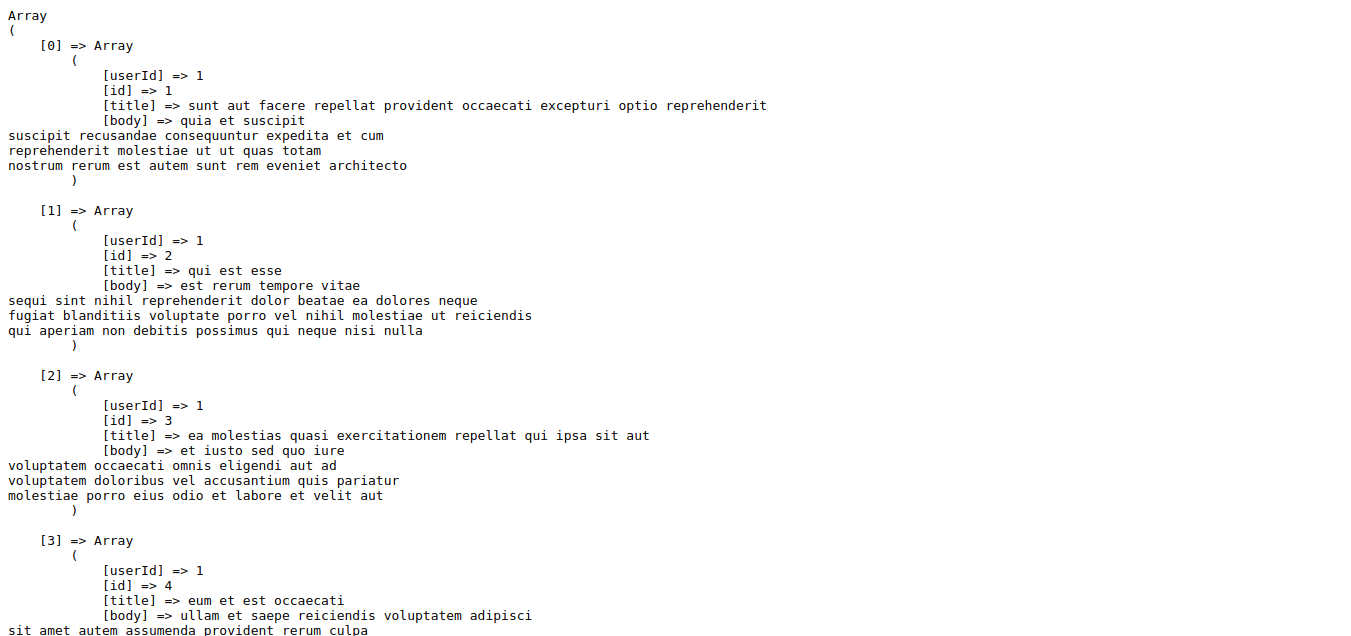How to HTTP Client Request example in Laravel 9?
Feb 18, 2022 . Admin
Hi friends,
In this tutorial, I am going to learn you how to http client request example in laravel9?. We will look at the example of laravel 9 HTTP guzzle request get,post and delete. Here you will learn how to create HTTP guzzle request example in laravel 9. it's a simple example of laravel 9 guzzle HTTP client example.
If i talk about the primordial era of web development, then at that time we used to rely on cURL for a similar tasks. But as time went by, there were many improvements. Out of that development, Guzzle is one, i would talk about the Guzzle HTTP client today.
This tutorial will give you an example of HTTP guzzle request example in laravel 9. you can understand the concept of HTTP guzzle request in laravel 9.
Here i will example of HTTP guzzle request example in laravel 9. So let's see the bellow example:
1) Laravel 9 HTTP cURL GET Request Example
2) Laravel 9 HTTP cURL POST Request Example
3) Laravel 9 HTTP cURL PUT Request Example
4) Laravel 9 HTTP cURL DELETE Request Example
Download LaravelLet us begin the tutorial by installing a new laravel application. if you have already created the project, then skip following step.
composer create-project laravel/laravel example-app1 - Laravel 9 HTTP cURL GET Request Example:
Here, we will see how to send curl http get request in laravel 9, let's update route file code and controller file code. you can see output as well:
routes/web.php
<?php
use Illuminate\Support\Facades\Route;
use App\Http\Controllers\HttpPostController;
/*
|--------------------------------------------------------------------------
| Web Routes
|--------------------------------------------------------------------------
|
| Here is where you can register web routes for your application. These
| routes are loaded by the RouteServiceProvider within a group which
| contains the "web" middleware group. Now create something great!
|
*/
Route::get('posts', [HttpPostController::class, 'index']);
app/Http/Controllers/HttpPostController.php
<?php
namespace App\Http\Controllers;
use Illuminate\Http\Request;
use Illuminate\Support\Facades\Http;
class HttpPostController extends Controller
{
/**
* Write code on Method
*
* @return response()
*/
public function index()
{
$response = Http::get('https://jsonplaceholder.typicode.com/posts');
$jsonData = $response->json();
dd($jsonData);
}
}
Output:

Here, we will see how to send curl http post request in laravel 9, let's update route file code and controller file code. you can see output as well:
routes/web.php
<?php
use Illuminate\Support\Facades\Route;
use App\Http\Controllers\HttpPostController;
/*
|--------------------------------------------------------------------------
| Web Routes
|--------------------------------------------------------------------------
|
| Here is where you can register web routes for your application. These
| routes are loaded by the RouteServiceProvider within a group which
| contains the "web" middleware group. Now create something great!
|
*/
Route::get('posts/store', [HttpPostController::class, 'store']);
app/Http/Controllers/HttpPostController.php
<?php
namespace App\Http\Controllers;
use Illuminate\Http\Request;
use Illuminate\Support\Facades\Http;
class HttpPostController extends Controller
{
/**
* Write code on Method
*
* @return response()
*/
public function store()
{
$response = Http::post('https://jsonplaceholder.typicode.com/posts', [
'title' => 'This is test from Mywebtuts.com',
'body' => 'This is test from Mywebtuts.com as body',
]);
$jsonData = $response->json();
dd($jsonData);
}
}
Output:
Array
(
[titile] => This is test from Mywebtuts.com
[body] => This is test from Mywebtuts.com as body
[id] => 101
)
3 - Laravel 9 HTTP cURL PUT Request Example:
Here, we will see how to send curl http put request in laravel 9, let's update route file code and controller file code. you can see output as well:
routes/web.php
<?php
use Illuminate\Support\Facades\Route;
use App\Http\Controllers\HttpPostController;
/*
|--------------------------------------------------------------------------
| Web Routes
|--------------------------------------------------------------------------
|
| Here is where you can register web routes for your application. These
| routes are loaded by the RouteServiceProvider within a group which
| contains the "web" middleware group. Now create something great!
|
*/
Route::get('posts/update', [HttpPostController::class, 'update']);
app/Http/Controllers/HttpPostController.php
<?php
namespace App\Http\Controllers;
use Illuminate\Http\Request;
use Illuminate\Support\Facades\Http;
class HttpPostController extends Controller
{
/**
* Write code on Method
*
* @return response()
*/
public function update()
{
$response = Http::put('https://jsonplaceholder.typicode.com/posts/1', [
'title' => 'This is test from Mywebtuts.com',
'body' => 'This is test from Mywebtuts.com as body',
]);
$jsonData = $response->json();
dd($jsonData);
}
Output:
Array
(
[titile] => This is test from Mywebtuts.com
[body] => This is test from Mywebtuts.com as body
[id] => 1
)
4 - Laravel 9 HTTP cURL DELETE Request Example:
Here, we will see how to send curl http delete request in laravel 9, let's update route file code and controller file code. you can see output as well:
routes/web.php
<?php
use Illuminate\Support\Facades\Route;
use App\Http\Controllers\HttpPostController;
/*
|--------------------------------------------------------------------------
| Web Routes
|--------------------------------------------------------------------------
|
| Here is where you can register web routes for your application. These
| routes are loaded by the RouteServiceProvider within a group which
| contains the "web" middleware group. Now create something great!
|
*/
Route::get('posts/delete', [HttpPostController::class, 'delete']);
app/Http/Controllers/HttpPostController.php
<?php
namespace App\Http\Controllers;
use Illuminate\Http\Request;
use Illuminate\Support\Facades\Http;
class HttpPostController extends Controller
{
/**
* Write code on Method
*
* @return response()
*/
public function delete()
{
$response = Http::delete('https://jsonplaceholder.typicode.com/posts/1');
$jsonData = $response->json();
dd($jsonData);
}
}
5 - Laravel 9 API with Response:
We will create very simple http request full example. we need to create simple route to call controller method. so let's create it:
routes/web.php
<?php
use Illuminate\Support\Facades\Route;
use App\Http\Controllers\HttpPostController;
/*
|--------------------------------------------------------------------------
| Web Routes
|--------------------------------------------------------------------------
|
| Here is where you can register web routes for your application. These
| routes are loaded by the RouteServiceProvider within a group which
| contains the "web" middleware group. Now create something great!
|
*/
Route::get('posts', [HttpPostController::class, 'index']);
app/Http/Controllers/HttpPostController.php
<?php
namespace App\Http\Controllers;
use Illuminate\Http\Request;
use Illuminate\Support\Facades\Http;
class HttpPostController extends Controller
{
public function index()
{
$response = Http::get('http://jsonplaceholder.typicode.com/posts');
$jsonData = $response->json();
echo "<pre> status:";
print_r($response->status());
echo "<br/> ok:";
print_r($response->ok());
echo "<br/> successful:";
print_r($response->successful());
echo "<br/> serverError:";
print_r($response->serverError());
echo "<br/> clientError:";
print_r($response->clientError());
echo "<br/> headers:";
print_r($response->headers());
}
}
Output:
status:200
ok:1
successful:1
serverError:
clientError:
headers:Array
(
[Date] => Array
(
[0] => Thu, 12 Mar 2020 06:08:58 GMT
)
[Content-Type] => Array
(
[0] => application/json; charset=utf-8
)
[Transfer-Encoding] => Array
(
[0] => chunked
)
.....
)
You can also get more information about Http Client in Laravel Docs: Click Here.
I hope it can help you...
